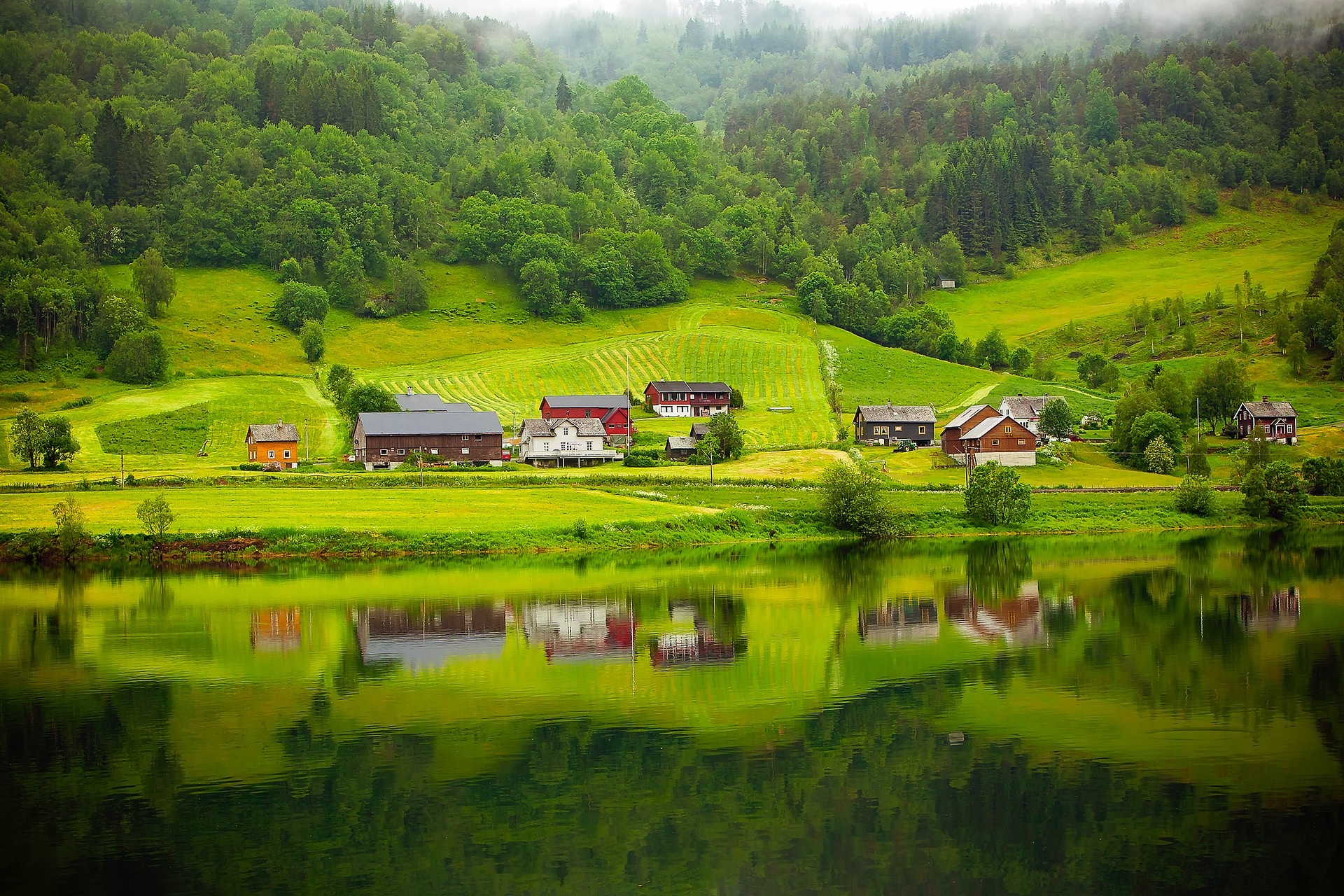When learning a new language, it is always useful to get familiar with its origins, history and those little details that make it unique. If you are thinking about learning Norwegian (or even visiting Norway), then this list may prove very useful.
1. Norwegian is a Scandinavian Language
Norwegian (norsk) is a North Germanic language with approximately five million speakers mainly confined to the Kingdom of Norway. Along with Swedish and Danish, Norwegian forms a dialect continuum, meaning that different dialects of these languages are mutually intelligible to some extent.
Spoken Norwegian has more of the harder consonants than Danish; “t” rather than “d” and “p” rather than “b”, for example, and less “fluid” pronunciation. One famous example of this difference is the Danish for “red ‘porridge’ with cream”: pronounced “roegroe meh floe-eh” in Danish, but “roegroeT me floeTe” in Norwegian. The Swedish version would be “roedgroet med grädde” (though the dish in question would likely be called fruktkräm instead). Notice that Swedish also uses a completely different word for “cream” (with an umlaut on top of the “a”, not used in Danish or Norwegian), but the pronunciation is closer to Norwegian.
The “red porridge” shibboleth illustrates the differences between the three languages: Norwegians find Danish easy to read but very difficult to understand spoken, whilst Swedish is more easily understood, as long as you know that “glass” is ice cream, not a receptacle for drink, as it is in Norwegian.
Norwegian uses the Latin alphabet and adds on the three characters æ, ø and å, for good measure.
2. Norwegian is written according to two distinct standards
Norwegian is not only Norwegian. More precisely, there are two standards for written Norwegian (and normative spoken language, as used in broadcasting): one called “bokmål” (book language) and “nynorsk” (new Norwegian). Bokmål is the modernised version of the Danish written standard that was used until the first major language reform in 1907. Nynorsk was created by linguist Ivar Aasen in the 1850s, based on various Norwegian dialects, with more than a nod to the pre-Danish, Norse past.
The movement away from Danish was fuelled by a strong, nationalistic need for cultural nation-building, when 300 years of Danish rule came to a screeching end in 1814. Two schools emerged: the reformers who wanted to gradually Norwegify Danish, and the New-Norwegianists.
In the famously inclusive Norway, both factions won, so schools in Norway now teach both versions of the one language, and if you write a letter in nynorsk to a civil servant, they are obliged by law to reply in kind. This has led to two things: letters from civil servants in rather bad nynorsk, and many immigrants feeling there is an unreasonable bar to employment in the civil service, because they find tackling nynorsk even more difficult than the indigenous population does.
For many years, there was a school of third-way thinking: samnorsk, which means “Joint-Norwegian”. This had the support of some politicians, most infamously the fascist politician Vidkun Quisling, but found little support among ordinary people or the poets and writers. Instead, after the war, the government kept pushing for reforms to bring the spelling standards of the two variants of Norwegian closer together, but by 1981 this drive was all but over.
Since the early 1980s, the line has been to allow several spelling alternatives for words in both written standards, to give greater freedom of choice. Unfortunately this has also given rise to much confusion for students and speakers of other languages trying to learn to write correctly.
3. Norwegian has several dialects
There are two official ways of writing Norwegian (with lots of spelling choice in both), but let’s not stop there. Norwegians have stubbornly held on to regional dialects that developed over the centuries and changed in different ways depending on whether they were spoken in a coastal region or inland.
The dialects are roughly divided into Eastern and Western (Western includes most of the coast and the North – basically one big coast – while Eastern covers the inland region and the capital Oslo). As a linguistic rule of thumb when it comes to Norwegian dialects, water connects and mountains divide. Norway has a mountain ridge that divides East from West, and the most distinct dialects are found in the more remote, mountainous areas (not surprisingly).
In addition to the Eastern and Western dialects, there is a much discussed distinction between rural and urban dialects. The city dialect of Bergen, for example, has only two grammatical genders, whilst normal Norwegian generously has three.
There is perhaps more of a conscious policy in Norway to retain and encourage use of dialect than in the other Scandinavian countries – or in Europe in general. There is as such no official norm for spoken Norwegian (although broadcasters will lean towards either nynorsk or bokmål). The use of dialects has been promoted nationally, and the current Prime Minister, Erna Solberg, speaks Bergen dialect, even in an official capacity (see above).
4. Norwegian has extremely long words
In English, compound nouns are used for some words, such as toothpaste, haircut or bedroom – the resulting words are fairly short and manageable. Noun-noun compounding is a very important part of the Norwegian language, and it often leads to the creation of extremely long words.
Norwegian compound nouns will not necessarily be listed in the dictionary, because you can, literally, make them up as you go along. Take for instance menneskerettighetsorganisasjoner, which means “human rights organisations”. This is not in the dictionary, but it is correct.
Nearly endless possibilities for new compounds lead to lots and lots of squiggly red lines when you write Norwegian on an electronic device. Thankfully, in a country with six months of winter darkness, this phenomenon also gives rise to one of the favourite pastimes of the Norwegian population: pointing out mistakes in compounding words. A much-loved example is the shop announcing they have a special offer on “lamme lår” (lame thighs), when they in fact mean to offer “lammelår” (leg of lamb).
5. The Norwegian language, like the landscape, goes up and down
One of the few things Norwegian has in common with Chinese is that it is tonal. Thankfully the intonation of words in Norwegian follows only a two-tone system, but it is enough to drop the language learner in it. “Tømmer” can either be “timber” or “emptying”. “Ta på” can either be “touch” or “get dressed”.
The meaning depends on whether the same phonemes are intoned with toneme 1 or toneme 2. Toneme one is a straight low to high tone, whilst toneme two has a dip at the start and then it rises again. The degree of rising depends on whether it is an Eastern or Western dialect. The Bergen dialect mentioned above is again in a class of its own, with no toneme distinction, and this is also the case for some Northern dialects.
6. Norwegian makes Norwegians unique
Most Norwegians love their language and they love talking about it – there is a long-running radio show called Språkteigen that deals with linguistic issues and answers questions from listeners, and there have been several television series dedicated to making light entertainment out of language.
In print and social media examples of wrong or funny use of language abound. Not least of the type: “Kvinne overrasket av ulv på vei til jobb”. This means “Woman surprised when she saw wolf on her way to work”, but the construction in Norwegian can read as if she was surprised by the wolf on his way to work. Which would indeed be surprising.
One reason the language is so important to Norwegians is the crucial role it played in the process of nation-building and the construction of an identity. When the Norwegian school authorities tried to impose the spelling standards from the reform in 1938 (joint-Norwegian) on school children, parents would use pens and cross out and correct the spelling in the textbooks, and there were even public bonfires of textbooks containing the hated spelling.
The debate about how Norwegian should be written and taught is not called “the language debate”, but “Språkstriden”, the language fight. They may hand out the Nobel Peace Price, but amid the cold snow Norwegians can get hot under the collar about really important things, such as the spelling of “snow”. The offical spelling is “snø”, but conservative language users prefer the spelling inherited from Danish: “sne”.
Generally, the progressive Norwegians are quite conservative about their language. In 1951, the Norwegian government decided that numbers should henceforth be read as fifty-one, not one-and-fifty. Today, well over half a century later, people still use one-and-fifty. That is, they use both. The old-fashioned way in private, and the new way in more formal settings. It can be used both ways in one sentence: “He was born in nineteen one-and-eighty, but she was born in eighty-five”.
Language is part of one’s identity, and Norwegians refuse to let it be dictated to them. The love of and respect for dialects is another example of this. By speaking their dialects, writing in bokmål or nynorsk, and counting in the wrong way, they continue to express their own, slightly contrarian, but certainly unique individual and collective identity, in a country they like to call “annerledeslandet” (the different country).

Nordic dialect map
Learn about the languages and dialects of the entire Nordic region with our interactive map.
Nordic dialect map
Learn about the languages and dialects of the entire Nordic region with our interactive map.




